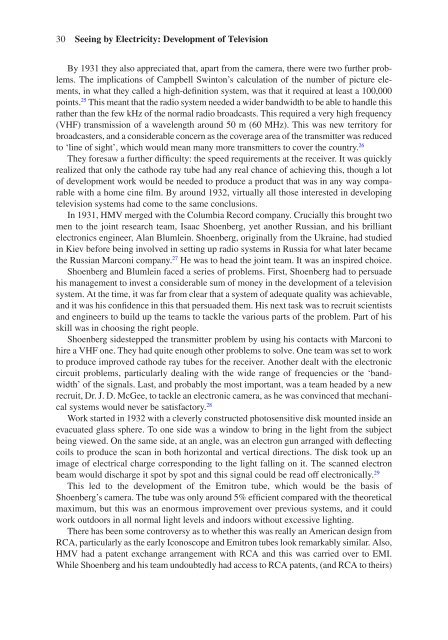The Electronics Revolution Inventing the Future
You also want an ePaper? Increase the reach of your titles
YUMPU automatically turns print PDFs into web optimized ePapers that Google loves.
30 Seeing by Electricity: Development of Television<br />
By 1931 <strong>the</strong>y also appreciated that, apart from <strong>the</strong> camera, <strong>the</strong>re were two fur<strong>the</strong>r problems.<br />
<strong>The</strong> implications of Campbell Swinton’s calculation of <strong>the</strong> number of picture elements,<br />
in what <strong>the</strong>y called a high-definition system, was that it required at least a 100,000<br />
points. 25 This meant that <strong>the</strong> radio system needed a wider bandwidth to be able to handle this<br />
ra<strong>the</strong>r than <strong>the</strong> few kHz of <strong>the</strong> normal radio broadcasts. This required a very high frequency<br />
(VHF) transmission of a wavelength around 50 m (60 MHz). This was new territory for<br />
broadcasters, and a considerable concern as <strong>the</strong> coverage area of <strong>the</strong> transmitter was reduced<br />
to ‘line of sight’, which would mean many more transmitters to cover <strong>the</strong> country. 26<br />
<strong>The</strong>y foresaw a fur<strong>the</strong>r difficulty: <strong>the</strong> speed requirements at <strong>the</strong> receiver. It was quickly<br />
realized that only <strong>the</strong> cathode ray tube had any real chance of achieving this, though a lot<br />
of development work would be needed to produce a product that was in any way comparable<br />
with a home cine film. By around 1932, virtually all those interested in developing<br />
television systems had come to <strong>the</strong> same conclusions.<br />
In 1931, HMV merged with <strong>the</strong> Columbia Record company. Crucially this brought two<br />
men to <strong>the</strong> joint research team, Isaac Shoenberg, yet ano<strong>the</strong>r Russian, and his brilliant<br />
electronics engineer, Alan Blumlein. Shoenberg, originally from <strong>the</strong> Ukraine, had studied<br />
in Kiev before being involved in setting up radio systems in Russia for what later became<br />
<strong>the</strong> Russian Marconi company. 27 He was to head <strong>the</strong> joint team. It was an inspired choice.<br />
Shoenberg and Blumlein faced a series of problems. First, Shoenberg had to persuade<br />
his management to invest a considerable sum of money in <strong>the</strong> development of a television<br />
system. At <strong>the</strong> time, it was far from clear that a system of adequate quality was achievable,<br />
and it was his confidence in this that persuaded <strong>the</strong>m. His next task was to recruit scientists<br />
and engineers to build up <strong>the</strong> teams to tackle <strong>the</strong> various parts of <strong>the</strong> problem. Part of his<br />
skill was in choosing <strong>the</strong> right people.<br />
Shoenberg sidestepped <strong>the</strong> transmitter problem by using his contacts with Marconi to<br />
hire a VHF one. <strong>The</strong>y had quite enough o<strong>the</strong>r problems to solve. One team was set to work<br />
to produce improved cathode ray tubes for <strong>the</strong> receiver. Ano<strong>the</strong>r dealt with <strong>the</strong> electronic<br />
circuit problems, particularly dealing with <strong>the</strong> wide range of frequencies or <strong>the</strong> ‘bandwidth’<br />
of <strong>the</strong> signals. Last, and probably <strong>the</strong> most important, was a team headed by a new<br />
recruit, Dr. J. D. McGee, to tackle an electronic camera, as he was convinced that mechanical<br />
systems would never be satisfactory. 28<br />
Work started in 1932 with a cleverly constructed photosensitive disk mounted inside an<br />
evacuated glass sphere. To one side was a window to bring in <strong>the</strong> light from <strong>the</strong> subject<br />
being viewed. On <strong>the</strong> same side, at an angle, was an electron gun arranged with deflecting<br />
coils to produce <strong>the</strong> scan in both horizontal and vertical directions. <strong>The</strong> disk took up an<br />
image of electrical charge corresponding to <strong>the</strong> light falling on it. <strong>The</strong> scanned electron<br />
beam would discharge it spot by spot and this signal could be read off electronically. 29<br />
This led to <strong>the</strong> development of <strong>the</strong> Emitron tube, which would be <strong>the</strong> basis of<br />
Shoenberg’s camera. <strong>The</strong> tube was only around 5% efficient compared with <strong>the</strong> <strong>the</strong>oretical<br />
maximum, but this was an enormous improvement over previous systems, and it could<br />
work outdoors in all normal light levels and indoors without excessive lighting.<br />
<strong>The</strong>re has been some controversy as to whe<strong>the</strong>r this was really an American design from<br />
RCA, particularly as <strong>the</strong> early Iconoscope and Emitron tubes look remarkably similar. Also,<br />
HMV had a patent exchange arrangement with RCA and this was carried over to EMI.<br />
While Shoenberg and his team undoubtedly had access to RCA patents, (and RCA to <strong>the</strong>irs)


















